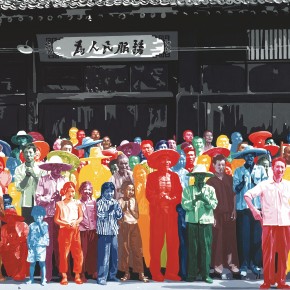
Gérard Fromanger, Londres, Tate Modern, jusqu'au 24/01/2016. Paris, Centre Pompidou, du 17/02 au 16/05/2016
Alors qu’il participe à l’exposition londonienne « The World Goes Pop », à la Tate Modern jusqu’au 24 janvier, Gérard Fromanger offre à partir du 17 février une magnifique rétrospective au Centre Pompidou. Il se livrait à Ouvretesyeux pour parler de son amour de la vie et de l’art lors de l’édition d’Art Paris Art Fair 2015 à la galerie Caroline Smulders. Témoignage sur ses dernières années de création.

Atelier de Gérard Fromanger, Paris, vendredi 14 novembre 2008, © Centre Pompidou, Bibliothèque Kandinsky

Hommage à Topino-Lebrun, 1975 – 1977 (2)La Vie et la mort du peuple, Huile sur toile, 200 x 300 cm, Centre Pompidou, Paris, © Gérard Fromanger, 2016, © Collection Centre Pompidou, MNAM-CCI/Dist. RMN-GP photo Philippe Migeat

Corps à corps, bleu, Paris-Sienne, 2003-2006, Série « Sens dessus dessous », Huile et peinture acrylique sur toile, 205 x 310 cm, Centre Pompidou, Musée national d’art moderne, achat, 2007 © Gérard Fromanger, 2016, © Collection Centre Pompidou, MNAM-CCI/Dist. RMN-GP photo Philippe Migeat

Florence, rue d’Orchampt, 1975, Série « Splendeurs I », Huile sur toile, 130 x 97 cm
Courtesy Galerie Jeanne Bucher Jaeger, Paris © Gérard Fromanger, 2016, © Courtesy Galerie Jeanne Bucher Jaeger, Paris photo Jean-Louis Losi
Le Centre Pompidou consacre une exposition à l’œuvre de Gérard Fromanger. Entre 1964 et 2015, à travers un parcours thématique composé d’une cinquantaine de peintures, de deux sculptures, d’une dizaine de dessins et d’un film, dans les espaces réunis de la galerie du musée et de la galerie d’art graphique, cette rétrospective inédite invite le public à découvrir les différentes expressions d’une dualité au cœur de l’art de Gérard Fromanger : la passion picturale et le souci du monde.
Le nom de Gérard Fromanger, sitôt prononcé, convoque pêle-mêle des images et des références, des thèmes et des figures : mai 68, des silhouettes rouges, des scènes de rue, Prévert, Godard, Deleuze, Foucault, le photoréalisme, la Figuration narrative, la peinture et la politique. Ces associations recomposent le décor et recréent l’atmosphère dans laquelle l’œuvre de Gérard Fromanger gagne une large reconnaissance dans les années 1970. Elles ne suffisent pas à définir le projet qui, par-delà les mutations fréquentes que l’œuvre a connues, et tout au long d’un demi-siècle, affirme sa permanence : une peinture ouverte sur le monde et en même temps pleinement consciente d’elle-même.
Le catalogue de l’exposition est publié par les Éditions du Centre Pompidou, par Michel Gauthier, commissaire de l’exposition et Olivier Zahm.
Centre Pompidou. Galeries du musée, niveau 4.
Du 17/02 au 16/05/2016.
Gérard Fromanger participe à l’exposition londonienne « The World Goes Pop« . Tate Modern. Jusqu’au 24/01/2016.
The EY Exhibition: The World Goes Pop is a groundbreaking exhibition revealing how artists around the world engaged with the spirit of Pop, from Latin America to Asia, and from Europe to the Middle East. Around 160 works from the 1960s and 1970s are brought together at Tate Modern – the great majority of which have never been shown in the UK before – exploding the traditional story of Pop art and showing how different cultures contributed, re-thought and responded to the movement.
Pop art is generally considered an Anglo-American phenomenon, a knowing but unconflicted reflection on modern commercial culture, associated with such artists as Andy Warhol and Roy Lichtenstein. This exhibition reveals the alternative stories of Pop, highlighting key figures of the era who have often been left out of mainstream art history. It also reveals how Pop was never just a celebration of Western consumerism, but was often a subversive international language for criticism and public protest across the globe.
Reacting to the market and media dominance of post-war America, Pop art arose in many countries and communities as an overtly political, destabilising force. The EY Exhibition: The World Goes Pop shows how artists used this visual language to critique its capitalist origins while benefiting from its mass appeal and graphic power. The exhibition includes the Austrian Kiki Kogelnik’s anti-war sculpture Bombs in Love 1962, and the subverted commercial logos of Boris Bućan in Croatia.
Pop’s comic-book blondes and advertising models have become familiar images of the idealised female body, but this exhibition also reveals the many women artists who presented alternative visions. The Pop body could be complex and visceral instead, from Brazilian Anna María Maiolino’s brightly coloured sculpture of digestive organs Glu, Glu, Glu 1966, to the paintings of cut-up and isolated body parts by Slovakia’s Jana Želibská and Argentina’s Delia Cancela. The EY Exhibition: The World Goes Pop also showcases many other women artists who played key roles in the movement, including Evelyne Axell, Eulàlia Grau, Nicola L, Marta Minujin and Martha Rosler, challenging the traditional cast of male figures who have come to dominate Pop’s canon.
Pop art is also traditionally associated with the hyper-individualised consumer and the isolated celebrity icon, but global Pop artists often found the amassed crowd to be a more potent symbol of contemporary culture. Icelandic artist Erró’s American Interiors 1968 showed throngs of Chinese workers invading domestic Western scenes, while Brazilian Claudio Tozzi’s Multitude 1968 and Spanish-based Equipo Crónica’s Concentration or Quantity Becomes Quality 1966 showed the modern energy and antagonism of crowds, in sharp contrast to American Pop’s remote icons like Marilyn and Elvis. Other artists even united a Pop aesthetic with their own folk traditions, bringing together contemporary imagery with local practices. The exhibition shows many such variations from across the globe, from Judy Chicago’s decorated car hoods to Beatriz Gonzalez’s painted Colombian dining table to Ushio Shinohara’s ‘popped’ versions of 19th century Japanese prints.
The EY Exhibition: The World Goes Pop is curated by Jessica Morgan, Director, Dia Art Foundation (formerly The Daskalopoulos Curator, International Art, Tate Modern), and Flavia Frigeri, Curator, Tate Modern, with Elsa Coustou, Assistant Curator, Tate Modern. Jusqu’au 24/01/2016.

